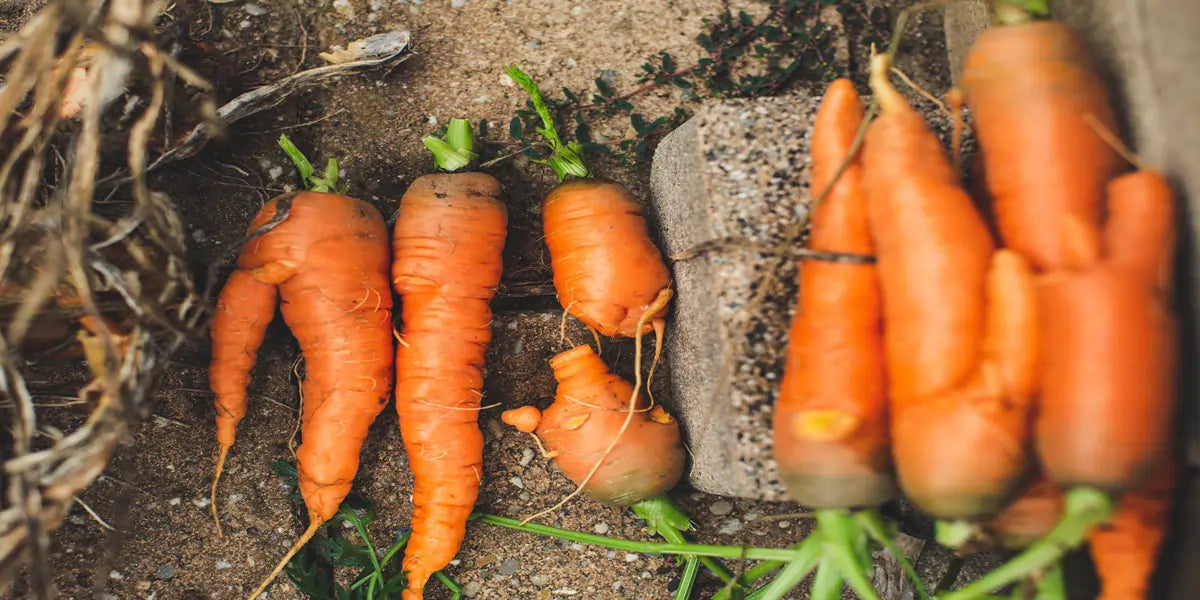It's time to plant carrot seeds again! To harvest carrots in early spring next year, you must plant carrot seeds as early as September or early fall! Carrots are a fussy plant, especially at the seeding stage. There are differences between growing carrots in the North and the South. Check out the fall carrot planting tips we have for you!
Learn about carrots
Carrots are a cool-season crop rich in vitamin A. Many home gardeners enjoy growing carrots in their backyards. However, carrots are difficult to grow, so they are not recommended for novice gardeners. Carrots like full sun and need at least 6 hours of light per day.

(different carrots)
This plant grows healthily in well-drained soil. If the soil in your garden is hard clay, it is recommended to grow carrots in raised garden beds. Raised garden beds are at least 8 inches in height.
Good carrots for planting in the fall
“Little Finger”
"Little Finger" carrots mature earlier than other plants. It takes only 60 days from germination to harvest. These carrots are small but very tasty. Due to its small size, you can grow it in small spaces, such as balconies and terraces.

(“Little Finger”)
Parisian heirloom
This carrot has a unique shape that is round and short and thick. Parisian heirloom is perfect for compacted, heavy, or rocky soil.
Parisian Heirloom loves the sun and can grow in USDA Hardiness Zones 3-9. Not only is this carrot flavorful, but it matures earlier than most carrots.
Solar Yellow
This special yellow carrot will bring more fun to your table. Solar Yellow is a crunchy, juicy, sweet carrot!

(solar yellow carrot)
This carrot has roots up to 7 inches long and can be harvested 60 days after germination. Solar Yellow is a great carrot for cool season growing.
Purple Carrots
This carrot is a deep, rich purple with a bright orange center. If you wish to try a novel variety of carrots, this carrot can bring you joy. Purple carrots take 65-70 days to harvest with shorter tops.
Growing Carrots in the South
For southern backyards, fall is the best time to plant carrots. In mild southern climates, gardeners usually sow carrots in early fall and harvest them in winter or early spring.
From South Carolina to Florida, gardeners can plant carrots outdoors without worrying about high winds or rain or snow.
Tips for growing carrots in the South
Gardeners in Florida, southern Texas, and southern California can grow carrots continuously throughout the fall and winter. Gardeners in these locations can harvest carrots in the winter.
Gardeners in the Upper South are best served by planting carrots in late August through September. The planting window in this region may be a little shorter than in the Mid-South, and if you're in the Mid-South, you'll need to finish planting by October. You will harvest super-sweet carrots in the cooler winter months!

(carrot varieties)
In warmer southern climates, you should store your carrots in a cool and dry place. Do not leave your carrots in the ground, the heat will affect your plants.
If you're growing carrots in a garden bed, it's recommended to have a shade cloth over the plants, which helps retain moisture and lower soil temperatures. Remove the shade cloth when the climate becomes cooler.
Growing carrots in the north
In the north, gardeners must For gardeners growing carrots in the north, greenhouses or tunnel greenhouses are great tools. By utilizing a greenhouse, gardeners can extend the growing season for carrots.
Carrots are great for growing in the north because the plant is very hardy. Gardeners can harvest super sweet carrots after a frost.
Tips for growing carrots in the north
If you are planting carrot seeds in late summer, be sure to prevent the seedbed from drying out or getting hot. Carrot seeds dry out easily and prefer well-drained and moist soil.
To grow carrot seedlings in late summer you need to be careful to keep the plants cool and remember to water them regularly.
Growing carrots in different places
Growing carrots in a greenhouse
Sowing time
If you plan to grow carrots in a greenhouse, you need to keep the temperature in the greenhouse under strict control. Carrots grow well in cooler temperatures, which should be around 75°F during the day and 55°F at night. If conditions in the greenhouse are right, you can grow carrots in the greenhouse all year round.

(carrot harvest)
We recommend that you choose a 10x20 greenhouse. This size greenhouse fits many home backyards. Quictent offers several 10x20 greenhouse options.
- 20' x 10' x 6.6' Upgraded Large Walk-in Greenhouse
This is an upgraded heavy-duty greenhouse. The top is equipped with 4 extra sets of top hoops to prevent damage from snow and rain buildup in the fall and winter. To avoid tearing at the seams, 100% waterproof and sturdy Oxford fabric is used to reinforce the greenhouse cover.
Each greenhouse window is fitted with Velcro to maintain a relatively higher temperature in winter than outside. In summer, 8 ventilation screens help with cross-ventilation.
In addition to growing carrots in the ground in your greenhouse, you can also grow carrots in raised garden beds. Quictent offers you a variety of sizes of raised garden beds, including the 49" x 37" x 36" Galvanized Garden Bed, the 8' x 4' x 2' Galvanized Raised Garden Bed, and the 6' x 3' x 1.5' Oval Galvanized Raised Garden Bed.
Thinning carrot seedlings
Carrots will sprout in two to three weeks. The gardener should keep a constant eye on the carrot seedlings and promptly weed out the weaker ones, but do not harm the leaves or stems. For healthy growth, leave two to three inches between seedlings.
How to Water
For healthy carrot growth, you need to keep the soil moist. But don't let the soil become soggy. Do not plant carrot seedlings in dry soil; this can cause the seedlings to die. Water the soil about an inch a week.
Watch out for pests
Carrot flies are a common pest during the growth of carrots. This pest is attracted to the odor of damaged leaves. To avoid this pest from harming your plants, you should check your greenhouse windows and doors frequently during the week, and you will need to open the screens to ensure airflow. Frequent checking and watering of your carrots can avoid or reduce the number of carrot flies.
Growing carrots indoors
Indoor gardening is becoming increasingly popular with many gardeners and you can grow carrots on your balcony or in a grow tent at any time of the year.
It is recommended that you grow carrots in pots. Gardeners need to provide loose and slightly sandy soil for carrots. Many good quality organic potting mixes are suitable for growing carrots.
Choosing the right pot
If you plan to grow carrots indoors in the fall, you should choose pots that drain well. This planter should hold at least 8 to 12 inches of soil with an additional 3 inches of clearance. The base is at least 4 inches wide.

(Growing carrots indoors)
Sowing Seeds
Begin by filling the planter with a moist potting mix and removing air bubbles. Leave about an inch of distance between the potting mixture and the rim of the planter for watering.
Place the seeds on the soil surface; seeds should be spaced one inch apart. The average germination rate for carrot seeds is about 60%. After placing the seeds, sprinkle a thin layer of moist potting mix over the seeds to cover them. At this stage, you can place the plants under a grow light. You can place the plants in an indoor greenhouse or grow tent for care.
Care tips
Carrots need light and water to grow. If the potting mix is too dry, the leaves will turn yellow. When the leaves turn yellow, simply water consistently, and the plant will recover.
Conclusion
Fall is the best time to plant carrots. Learning about tips for growing carrots in the fall can make your fall gardening easier! Backyards and indoors are both perfect places to grow carrots, as long as you do it the right way! We wish you a bountiful harvest next spring!








